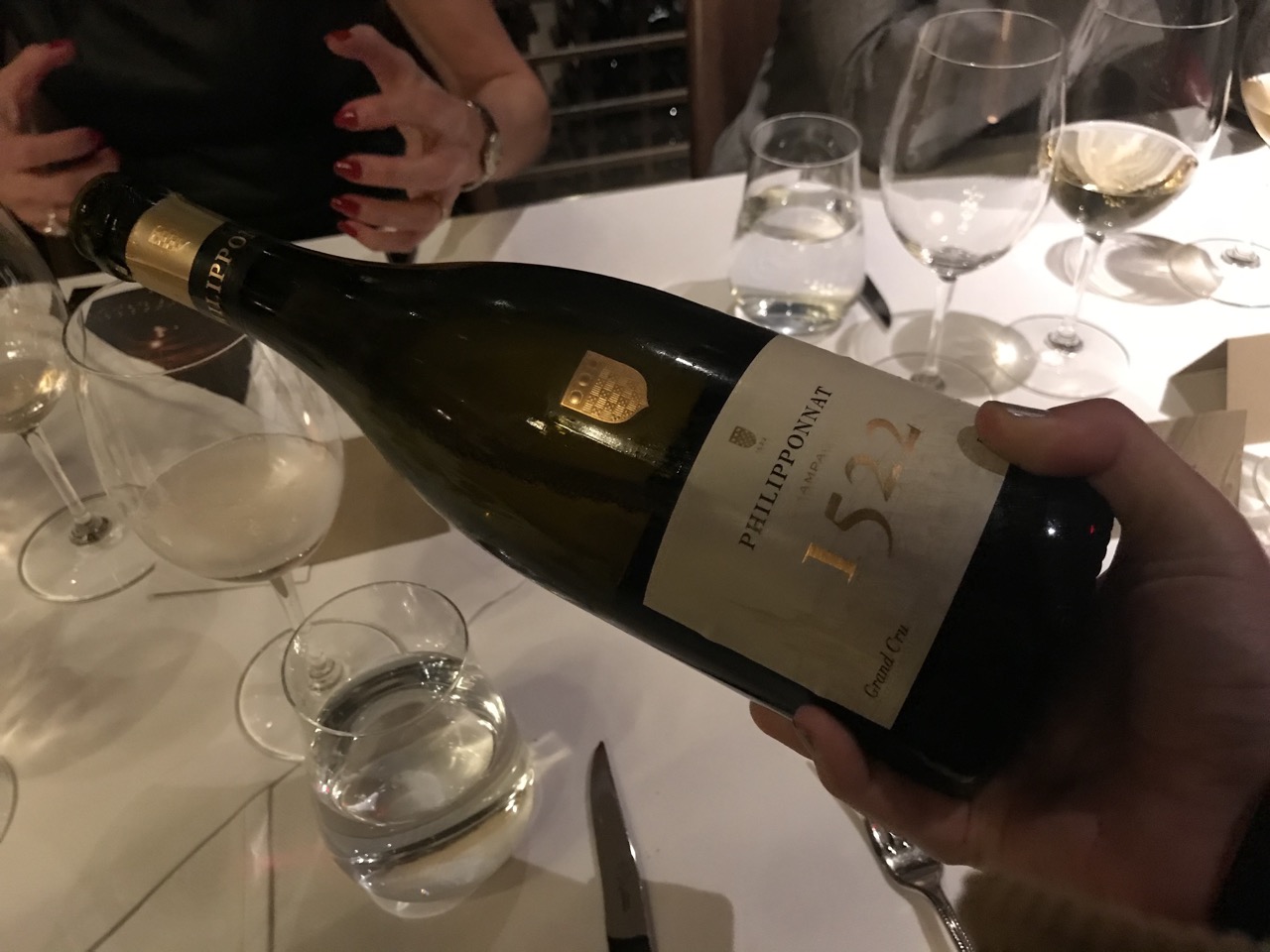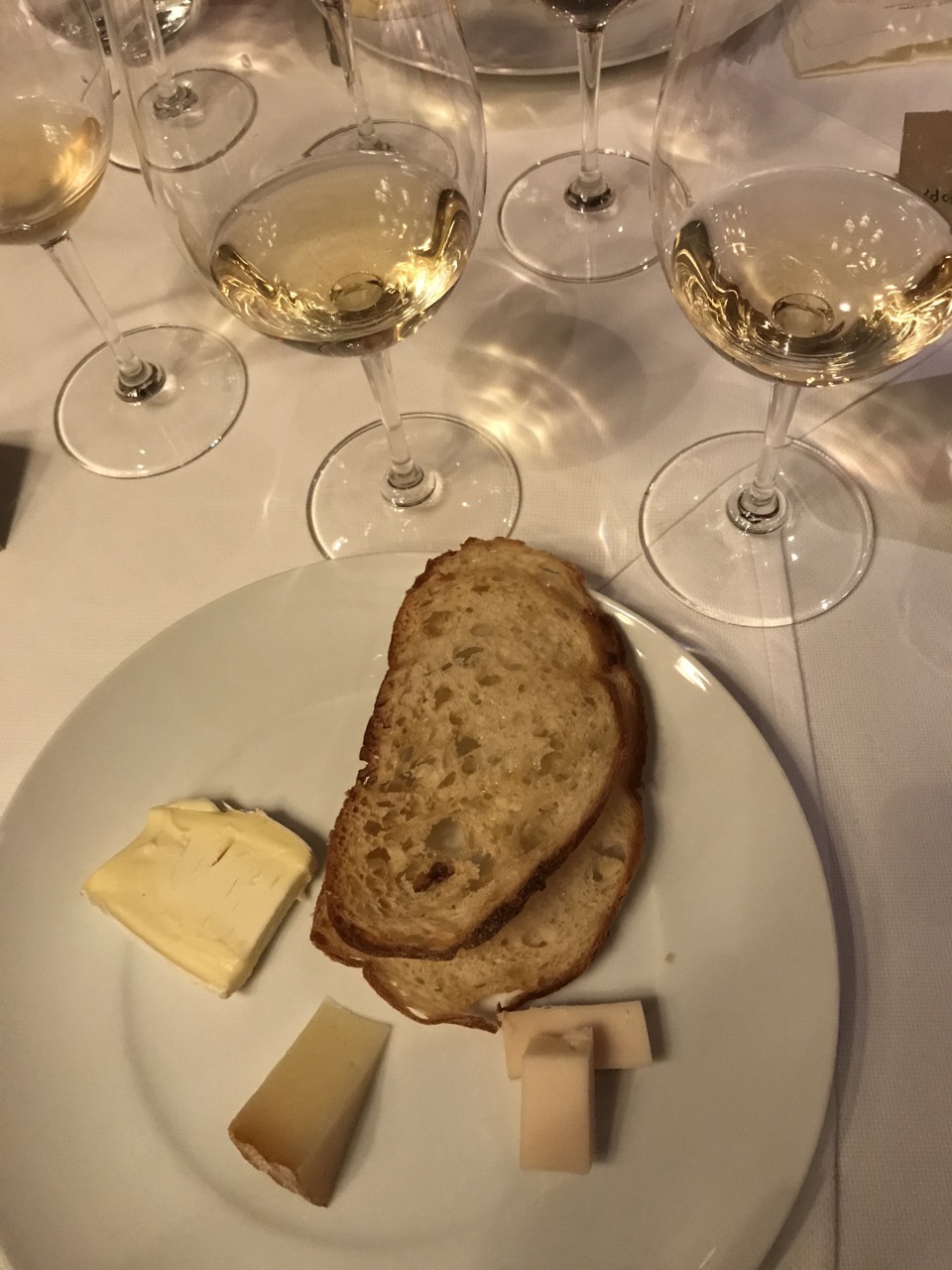From 1522 to 2018: Enjoying Philipponnat Champagne

Champagne evening at Mirabelle Restaurant in Washington D.C.
By Panos Kakaviatos for wine-chronicles.com
9 November 2018
When asked by Heidi Arnold of the famous Heart’s Delight Wine Auction here in Washington D.C. if I wanted to join a special Champagne dinner with Charles Philipponnat, I hesitated to reply for … not even a second.
Over the years, I have always enjoyed the Clos de Goisses cuvée of this famous Philipponnat Champagne house.
But I had not yet tried the “1522” bottling, which is made partly from grapes grown on vines on a plot that had been purchased by the Philipponnat family way back in… 1522, and which is still part of the Champagne house today.
A blend of 65% Pinot Noir and 35% Chardonnay, the Pinot Noir comes from that famous and very old plot purchase called “Le Léon” in Aÿ. The Chardonnay in the blend comes from vines at Mesnil-sur-Oger. Owner Charles Philipponnat inaugurated this wine only in 2000, and it was great to enjoy it with delicious roasted quail, stuffed with mushrooms, spinach, chestnut bisque and hazelnuts and bacon.
The quail was tender and tasty – and the wine matched it perfectly, as this 2007 vintage of “1522” conveyed richness yet fine acidity and bubbles, very elegant. Indeed, the wine’s freshness is preserved as a portion of the wines are vinified in wooden barrels without malolactic fermentation. Dosage is low at 4.25 grams per litre, which is just one third of the “conventional dosage” for a brut champagne. It is aged for eight years in bottle on the dead lees, which lends complexity.
About the venue and the people
This and other excellent bubblies were enjoyed by some 24 participants at a dinner gathering at Mirabelle Restaurant in downtown Washington D.C.
I had met restaurant director Jennifer Knowles at a wine dinner I organized at the famous Ripple restaurant in Washington D.C. a few years ago. Her grace and precision in describing each food that was paired with the wines impressed us all, as did the creative, refined cuisine of executive chef Keith Bombaugh, as you will read in further descriptions of his culinary work paired with Philipponnat wines below.
It was great to meet dinner co-organizer (and Instagram follower) Sarah Bray of VinConnect, a company that creates direct purchasing links to wine domains in Europe.
Company representative Kevin Sidders sat next to me at my table, and we had already met a few years back at ProWein in Düsseldorf, Germany.
Meeting a Supreme Court justice, too
A most unexpected encounter à table was meeting Supreme Court Associate Justice Sam Alito, who sat opposite me at the dinner table. Appointed to the prestigious court over 10 years ago by then President George W Bush, he explained that his last name originally was “Alati”, meaning salt in Greek, and that his ancestors came from Sicily. His interest in wine has been growing over the last 10 years, with a particular focus on Italian wines. We only spoke a bit about his work at the very end of the dinner, and he mentioned how much he admires the work of the European Court of Human Rights, which I represent as a media officer for the Council of Europe.
In addition to making new wine friends, I saw older friends including fellow wine aficionado Conrad Kenley.
Dinner …
We started things off with the basic Royale Réserve Brut NV, nicely aged for just under four years on the dead lees in bottle: much more than most NV Brut Champagnes.
Mainly made from premier cru and grand cru grapes (65% Pinot Noir, 30% Chardonnay and the rest Pinot Meunier), this 2012 edition includes up to 30% of earlier vintages aged in wooden casks using the solera system. Only partial malolactic fermentation maintains freshness and the wine was rich, with some gooseberry accents and then toasted brioche, especially on the medium finish.
Pumpkin Patch and Royal Reserve Rosé
Next came a more enjoyable Rosé Reserve NV whose base wine is the 2009 vintage: perfect for the 75% Pinot Noir in the blend that also includes 20% Chardonnay and 5% Pinot Meunier from premier and grands crus vineyards. I had a somewhat short pour and wanted more! It was truly delicious, with mandarine aspects as well as red berry fruit. So indeed, still fruity and fresh. Although a 2009 (with up to 30% reserve wines), it was still sparkling and vivacious, with just 4 grams of sugar per liter (not the nine as listed on the company website). The spice roasted pumpkin with cashew milk and butter finished with pumpkin oil was a fun autumnal pairing, as its richness was nicely complemented by the rosé bubbly.
Seared scallop with 8-0 and 0-8
I absolutely adored the seared scallop.
The quality of the scallop was fantastic, and its flavor was perfectly accentuated with a refined kombu seaweed cream sauce, caramelized onion and pickled apples (just on top of the scallop, in the picture).
With this course we had the Grand Blanc Philipponnat 2008 and … 1980! The Grand Blanc series is atypical for Philipponnat, as the house highlights more the Pinot Noir. But this brand is 100% Chardonnay and for our dinner an “8-0 and 0-8 comparison”, Charles joked.
The wines alas were not the most interesting of the evening, if only because the 1980 was a bit past due and the 2008 too young. I liked the laser focus of the 2008, but it was just a bit too austere to optimally “parry” the cream sauce and the seared scallop. Give the 2008 a few more years to settle, and I bet it would prove a better match. As for the 1980, there was bottle variation, so perhaps our table got a bottle that was more madeirized than others.
Next came the aforementioned and described 1522 Champagne, which was a highlight.
Clos des Goisses 1999 and 2009 – and 1992 and 1991 (from magnum)
Finally, we came to the “prestige” brand of Philipponnat, the Clos des Goisses and the course pairing – three excellent cheeses! – was nothing short of superb. Clos de Goisses is a walled, 5.5 hectare vineyard and one of the region’s few “clos” and the oldest and steepest in Champagne. It is produced using grapes from vines grown on a pure chalk hillside with a 45° slope facing full southern exposure at Mareuil-sur-Aÿ.
The word Gois or Goisses means “very steep slope” and temperatures here are often a full 2 degrees higher than the average in the region. “So if others are picking grapes at 10 percent, we are picking at 12 percent”, Charles remarked. Which begs the questions: “What about climate change?” and “Are you not concerned”.
Well, if you want the answers, check out my video ? below …
We were not finished just yet as Charles Philipponnat also brought a special after-dinner Grappa, too, made from non-fermented Clos des Goisses grapes. Unlike most Marc de Champagnes, this is not aged in wood, so it has a brighter aspect, Charles said. An Italian distiller creates the Grappa for Philipponnat, but only 1,000 bottles are produced a year.
 Wine Chronicles
Wine Chronicles








Share This